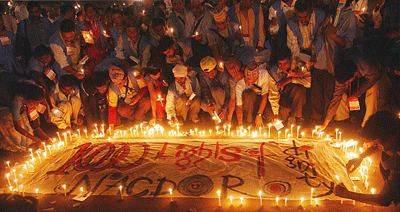The vídeo below is about 160 million people in India that are born outside the four castes of the Varna system – the oldest surviving social hierarchy of the world. They are called the “untouchables”. They themselves have chosen the name Dalits (broken people).
The term “Dalit” holds different meaning for different people. The most common use of the term is to define people who were once known as “untouchables”. Navsarjan describes the term in the ideological context as “a moral position of people who believe in and practice equality with all”. Dalit identity has so far been associated with caste. Dalits have indeed, from time immemorial, been socially and economically oppressed, culturally subjugated and politically marginalized. The movement for assertion of rights, aimed at ushering in a new social order based on the principles of equality and liberty, has been stronger in recent times than earlier. Even though many Dalits have reached positions of power and prominence, the vast majority of them continue to suffer untouchability, discrimination, poverty and humiliation and are daily targets of inhuman atrocities.
A past passive participle of the Sanskrit root dal that means to crack or to split, the word Dalit is today common across all languages. It means the poor and oppressed persons. As it refers to those who have been broken, ground down by those above them in a deliberate way there is also clearly an inherent denial of pollution, karma and justified caste hierarchy to the word itself. Though the term Dalit is of relatively recent origin – of the 1960s – in public discourse, it is supposed to have been used first by Jotirao Phule (1827-1890) in his attempt to work for dalituthan, that is, the upliftment of the exploited sections of society. And while Dr. Ambedkar did not popularise the word Dalit, his philosophy has remained a key source in its emergence and popularity. Indeed, Marathi literary figures and neo-Buddhists began to use the word in their writings and contributed to the literary initiatives in replacing Harijan (man of God) and achchuta, i.e., untouchable with the term Dalit, in the 1970s. They expressed their anger, protest and aspiration through this new word, obviously rejecting the Hindu caste system and objecting to Gandhi’s belief that caste Hindus’ “charitable spirit” would overcome Untouchability (http://www.navsarjan.org).
Some coments about this vídeo
This is just an 11 minute clip from an almost 1.5 to 2 hours long documentary film that I had seen at Tata Institute of Social Sciences in Mumbai!
There were about 70 people initially at the hall to see this documentary. Bul all except 3 peaple could not stand it till the end to see the reality of “Ïndia Shining”
…
This video highlights the discrimination most Indians are aware of but feign ignorance or sweep under the carpet. This is the reality and the world must come to know of it and take the govt and people to task.
…
This is the real India…not mumbai..not delhi…Its makes me feel sick that I live in a country where people are treated worse then animals
…
I was moved to tears. With activist work like this, I hope the rich become poorer, and the poor richer…I hope I can grow up to be a good Dalit, one day.
[pt_br]
Foto: Este foi um dos momentos emocionantes do FSM 2004, em Mumbai, quanto participantes da Conferência Nacional das Organzições Dalits (NACDOR) acenderam velas em sinal de sua luta por dignidade
O vídeo abaixo mostra como é a vida de 160 milhões de pessoas na India discriminadas por terem nascido fora das quatro castas do sistema Varna – a mais antiga hierarquia social sobrevivente no mundo. Elas são chamadas “ïntocáveis”. Mas batizaram a si mesmas de Dalits.
Alguns comentários sobre o vídeo “Como vai? sou Dalit”, produzido pela organização da Solidariedade Internacional com o povo Dalit sobre a realidade que ainda vivem:
Este é apenas um clip de 11 minutos sobre um documentário de 1h30 a 2 horas de duração que eu assisti no Instituto Tata de Ciências Sociais em Mumbai. Havia cerca de 70 pessoas na sala no começo da exibição, mas apenas 3 delas conseguiu ficar até o fim para ver a realidade da “India Shining”
…
Esta é a India real …não é Mumbai…não é Delhi…Me faz sentir doente de viver em um país onde pessoas são tratadas pior do que animais
…
Com um trabalho ativista como este, eu quero que os ricos fiquem pobres e os pobres ricos. Eu espero crescer para ser um bom Dalit, algum dia.
Acesso através do blog Shivanjiv (Youtube)




